
Philadelphia in 1754
An east prospect of the city of Philadelphia; taken by George Heap from the Jersey shore,
under the direction of Nicholas Scull surveyor general of the Province of Pennsylvania

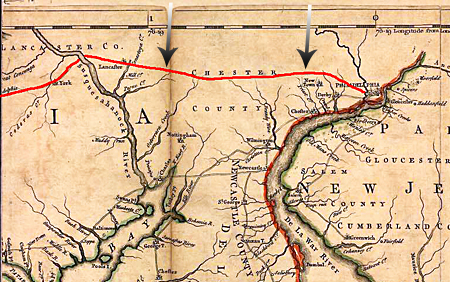
|
|
Land Route most likely taken by Thomas Friederich Fisher, 1751
The Fry-Jefferson map of the royal colony of Virginia (1752) Larger view of map | Wikipedia Page (source document) |
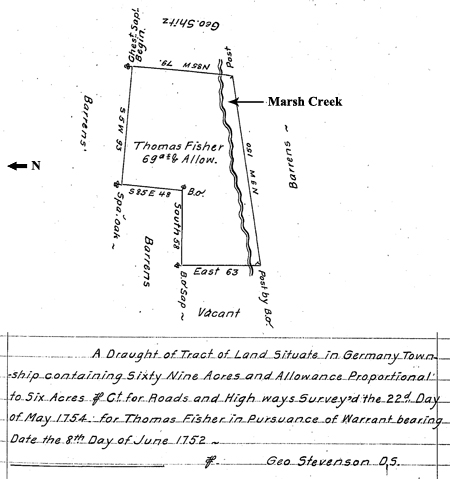
|
|
Thomas Fisher Land Warrant June 8, 1752 (Larger view of map) |

|
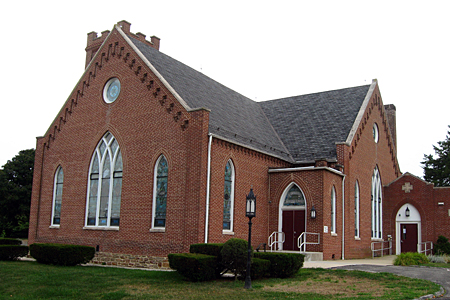
|
|
St. John's Lutheran Church Littlestown, Pennsylvania |

|
|
1756 T. Kitchin Map
(Larger view of map) |
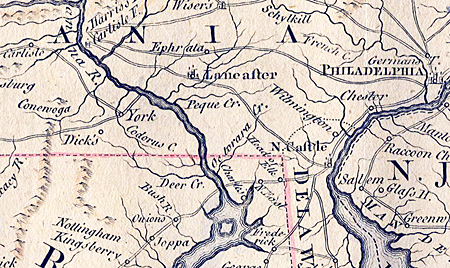
|
|
1757 Map - Northern Maryland & Southeast Pennsylvania
(Larger view of map) |
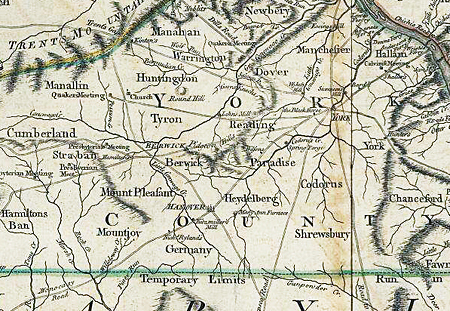
|
|
1770 W. Scull Map - York & Lancaster Counties
(Larger view of map) |
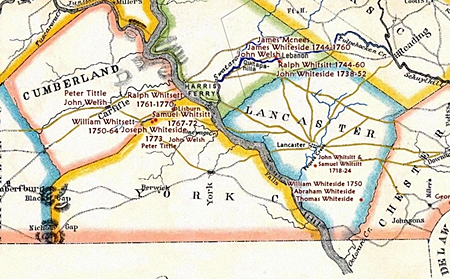
|
|
1791 Reading Howell Map - York & Lancaster Counties, Pennsylvania
(Larger view of map) |

|
|
1858 Map - Mount Joy & Germany Townships Adams County, Pennsylvania (Larger view of map) |

|
|
1749 Evans Map - Lancaster Pennsylvania Area
(Larger view of map) |
Thomas Friederich Fisher, born August 11, 1728 in Stuttgart, Wurttenburg, Germany, died 1793 in York County, Pennsylvania (view  in Germany). Thomas Friederich Fisher married (1) Maria Eva King (Koenig), born January 15, 1728, died 1781 in Germany Township, Adams County, Pennsylvania, USA. (eight children) Thomas Friederich Fisher married (2) Catherine Linebacher Graeff Miller. (one child)
in Germany). Thomas Friederich Fisher married (1) Maria Eva King (Koenig), born January 15, 1728, died 1781 in Germany Township, Adams County, Pennsylvania, USA. (eight children) Thomas Friederich Fisher married (2) Catherine Linebacher Graeff Miller. (one child)
Thomas Friederich Fisher's parents were Georg Albrecht Fisher, born 1682 (ancestry.com page for Georg Albrecht Fisher) (PDF file), Württemberg, Germany, died May 20, 1736; and Maria Christiana Faber, born January 1689. Georg Albrecht Fisher married September 22, 1711 in Berg (Stuttgart), Wurttenburg, Germany Maria Christiana Faber (ancestry.com page for Maria Christiana Faber).
 Georg Albrecht Fisher's parents were Rev. Johann Bartholomaus Fischer and Dorothea Bibiana Plaustarius (view the ancestry.com page for Rev. Johann Bartholomaus Fischer) and (view ancestry.com page for Dorothea Bibiana Plaustarius).
Georg Albrecht Fisher's parents were Rev. Johann Bartholomaus Fischer and Dorothea Bibiana Plaustarius (view the ancestry.com page for Rev. Johann Bartholomaus Fischer) and (view ancestry.com page for Dorothea Bibiana Plaustarius).
 Dorothea's father was Tobias Plaustarius (1603-1661) (view ancestry.com page for Tobias Plaustarius).
Dorothea's father was Tobias Plaustarius (1603-1661) (view ancestry.com page for Tobias Plaustarius).
 Johan Bartholomäus Fischer's father was Tobias Wagner (1575-1632) (view ancestry.com page for Tobias Wagner).
Johan Bartholomäus Fischer's father was Tobias Wagner (1575-1632) (view ancestry.com page for Tobias Wagner).
Fisher Family Immigration
The book Pennsylvania German Pioneers states that Thomas Friederich Fisher and [his brother] Jacob Fisher arrived together [in the colonies] in September 1751 at Philadelphia from Rotterdam via Portsmouth, England on the ship Phoenix. Thomas, who signed in English script, must have been at least 16 years old, while Jacob, who apparently was older, signed in German script. The names of children and women on this boat are not given. but one may have been Jacob, Jr.It is believed that Thomas and Jacob Fisher departed Philadelphia for Lancaster County very soon (if not immediately) after their arrival in America. On his May 5, 1752 Land Warrant, Jacob states that he is from Lancaster County. Thomas Fisher states that he is from York County in his June 8, 1752 Land Warrant.
The Atlantic Crossing
The Call of ToleranceGerman immigrants were among the first Europeans to set foot in North America. They helped establish England's Jamestown settlement in 1608 and the Dutch colony of New Amsterdam--now New York--in 1620. German adventurers could be found roaming the farthest reaches of the New World for many years afterward. It was religious tolerance, though, that first brought large numbers of Germans to North America.
During the 17th and 18th centuries, many European powers forced their subjects to follow an official state religion. Therefore, when William Penn toured Germany in 1677, spreading the word of a new kind of religious freedom in the American colonies, he found a receptive audience. Many Germans, especially Protestants, were persuaded to join him in his colony of Pennsylvania. Members of smaller sects, who were often persecuted in Europe, were especially eager to escape harassment, and German Mennonites, Quakers, and Amish emigrated in substantial numbers. Germantown, Pennsylvania--now part of Philadelphia--was established by 13 Mennonite families in 1683, and thousands of their fellow freethinkers and religious dissenters soon followed suit.
The journey to the colonies was not an easy one, though. Many of the first German immigrants came from the small Palatinate region in southwestern Germany. They began their travel by riverboat on the Rhine River, and then made their way to Holland. It took several weeks to reach an Atlantic seaport, and another eight to 10 weeks of difficult and dangerous ocean travel before they reached the shores of North America. To pay for their voyage, many impoverished immigrants resorted to selling themselves or their family members into indentured servitude--agreeing to be legally bound to an employer in America for several years, until their debt was paid. The conditions of indentured servitude could be very harsh; for instance, if an indentured child died before the contract was completed, the child's parents or siblings might be forced to work the remaining years of that contract, in addition to their own. Indentured servitude, unlike slavery, was entered into voluntarily, but it is still easy to see why German immigrants might have made a significant contribution to the anti-slavery movement in the United States.
Drawn by the prospect of inexpensive land, German immigrants quickly moved to settle on the fringes of the new colonies. Soon the river valleys of New York and Ohio were dotted with new German towns, and German settlements sprang up in Maryland, the Carolinas, and Georgia. Their stronghold, though, was still Pennsylvania. By 1745, more than 40,000 Germans lived in the colony, founding towns and villages with such distinctively German names as Manheim, Dunker, and Berlin. Many of these early communities maintain their German character to this day, especially in the Pennsylvania Dutch regions. (The term Pennsylvania Dutch was the result of Anglophone mispronunciation of the German word Deutsch, which means "German.")
The Amish, who are members of an especially reclusive religious denomination, still speak German, reject modern conveniences, and retain the dress and way of life of the Pennsylvania German farmers of centuries ago.
The Atlantic Crossing
Source: A Persistent Minority, by William T. Parsons
The following excerpt from Pennsylvania Germans, A Persistent Minority by William T. Parsons is posted for its excellent discussion of conditions confronting early 18th century German immigrants on the voyage to America and upon arrival at the Port of Philadelphia.
Large numbers of prospective migrants to America met at Rotterdam, a site very suitable for travelers who had come down the Rhine from their towns and farms upstream. The Neckar River valley had been home for many of them. Rotterdam was a sizable flourishing trade center, one of the two major shipping centers in the Low Countries. In many ways, Rotterdam was the typical trading port of its time. Cluttered dock and shipping facilities and bustling street markets with crowded living quarters were an indication of its prosperous condition. The addition of thousands of Germans, fleeing from districts their families had inhabited for generations, placed a great strain on the city. Merchants and shippers looked upon them as living cargo, to be accommodated the same way any cargo was.
Germans found the surroundings strange yet congenial, although for most of them this was merely a stopping place on the way to America. Some remained in Rotterdam, becoming a part of the varied population of that trading center; but most of the Rhineland travelers, on their way to the promise of the New World, found it too commercial or too worldly. The little substance that these poor wanderers had gathered for the voyage to America was dissipated by even a brief spell in or near the port. Many who left their German homes in a solvent financial condition departed Rotterdam without any funds (and very few goods) at all.
Most had found their way down the river valleys of the Neckar and the Rhine by available river transportation. Many others simply walked or pulled their carts of possessions along the paths which fed into the river valley system of roads, highways and bridges. Whether they brought their families with them depended somewhat on local and personal circumstances. Usually the father of the family tended to make the voyage alone. When it became economically feasible, he later sent for his family. Yet a surprising number of the Palatines and other minority Germans brought all or most of the family with them, uncertain as they were of the prospects at the American terminus of the trip.
From the several detailed accounts of the ocean crossing which have come down to us, it seems quite evident that the voyage was the chief hazard or obstacle of the flight from Europe to America. Many who had never sailed before crowded the small vessels with poor sailors and rotten accommodations. They lived for six to eight weeks in cramped space on board, holding fast to the trunks, chests or baggage which contained all their worldly wealth. They were fortunate to find deck space.
Many of the families on their way to Pennsylvania were crowded onto ships that carried double the number of passengers the vessels could theoretically accommodate. In those cramped and crowded conditions, numerous passengers died at sea. So extensive was the list of casualties that ship captains finally settled upon a formula on how to avoid an excessive number of deaths which reduced their cargo. Occasionally fatalities also made them subject to quarantine regulations in the American ports. They agreed (and by the 1740s made it part of the verbal contract with prospective passengers) that the halfway point of the voyage was the critical time. If a passenger died before the vessel had traveled half the distance to Pennsylvania, then the captain would bear the expense and the corpse was reckoned as no fare. If, on the other hand a passenger died after the halfway point of the voyage, then his family must pay full fare to America, even though he was buried at sea.
Various accounts of the passage have survived, leaving a literature of frustration and suffering. Few of the accounts make the experience appear pleasurable; most of them summarize weeks and months of hardship and deprivation. One such description by John George Jungmann of a sea voyage of the ship Love and Unity, in the years 1731-32, relates the problems in detail.
Originating at Rotterdam the vessel made port in Falmouth, adding supplies and food there. Twelve days out of Falmouth, the captain declared half the journey had been completed; five months later, the ship had not yet sighted land in America, but after nearly six months on the high seas, they came ashore at Martha's Vineyard. The emaciated passengers told tales of intense suffering. After eight weeks their bread and water had to be rationed, but during the last six weeks before Christmas, no bread ration was distributed and water was apportioned at a pint per family per day. Ship rats sold at a shilling sixpence and mice at sixpence each, when available. Deaths on this terrible voyage ran exceptionally high. Only four dozen persons reached American soil of an original passenger list of one hundred fifty-six. Barely forty, represented by a mere thirteen heads of families, eventually reached the original destination of Philadelphia, and that by the compassion of a Quaker master who happened upon them at Boston. The survivors claimed the only final choice they had was mutiny, whereby they forced the ship to make a landfall.
Ordinarily, for a six- to eight-week voyage, the captain's costs were modest. To feed hundreds of passengers cost him a few pennies per week. In return for the food he supplied, the master was ordinarily well reimbursed. Cash customers paid from three to five pounds when they landed. In 1750 adults paid ten pounds for passage. Ten to 20 percent of the passengers paid cash fares. Time of the year, conditions in Rotterdam, and the particular individuals transported determined passenger distribution. Prospective employers (or occasionally, prospective husbands) bought up indentures or contracts of the remaining mature arrivals, at profits which exceeded the cash fares for the masters or ship captains. Underage passengers without families were nearly always apprenticed or bound out. Philadelphia ship captains late in the 1740s generally agreed that human cargo was more profitable that cloth or hemp. Many captains could scarcely restrain themselves as the shipped from Rotterdam with a 100 percent overload of such human cargo.
The ocean passage required six weeks under favorable conditions, but even then preliminaries at Rotterdam and Cowes added days or weeks to the voyage. Debarkation at Philadelphia was sometimes delayed because of wind and tide, or due to mercantile or port requirements and official red tape. Food consumption from the traveler's own stock was apportioned for a six weeks' crossing. When that was gone, they subsisted on meager rations from the ship's stores, at inflated prices. Occasional suffering from storm delays or navigational miscalculations, as described above, affected both crew and passengers, but especially the latter.
Journey's end caused loud celebrations and extended rejoicing among the weary passengers. Those who had, weeks earlier, given up all hope of ever reaching port, now offered up thanks to God for their safe arrival after their journey across "the very big sea." Even the broad Delaware River reminded many of them of the familiar Rhine River in its lower reaches, broad, smooth-flowing, and bordered by impressive natural growth on both banks, with occasional dwellings and out-buildings visible.
Philadelphia was an eye-opener for the migrants who arrived between 1717 and 1754. The majority of Germans came from farms or rural villages. Philadelphia was a major population center, although in 1717 its population numbered under ten thousand. Penn's capital was a very young city, just beginning to grow, with much space for development and improvement. The leading Quaker city had been built to accommodate trade, as the number of docks, ships, and taverns particularly illustrated. On the whole it contained broader streets, larger lots (although many tiny ones existed as well), and newer construction than that of any town or city they had passed through on their way to America.
Wide streets and broad thoroughfares were particularly evident in this model town, although narrow back streets and alleys could be found. At the insistence of William Penn and because of its recent development, Philadelphia was much more a planned town than the ancient and often archaic villages the German migrants had left. Implementation of the Proprietor's plans was often imperfect, but the effort to provide "a green country town" bore results. It was true that new streets and roads under harsh weather conditions became virtually impassable quagmires.
Still, the overall impression was a favorable one, however novel and strange to the migrant in transit. Philadelphia grew rapidly during the great Palatine migration boom. It had a population of perhaps thirteen thousand in 1740 and nearly twenty thousand by 1754; the population of forty thousand by 1776 turned Philadelphia into the second largest British city in the empire, second only to London itself. It had surpassed Boston and all the other port towns of the Atlantic coast in a remarkably short time. Before the end of the high migration of Palatines, Philadelphia enjoyed streetlights and the beginnings of paved cartways and sidewalks along the major streets of the town.
To the immigrant from Württemberg or the Palatinate, confined to shipboard in the harbor, nearby Philadelphia was both awesome and welcome. In many ways, it represented the New Land, no longer far off. Yet, standing as an achievement of English Quaker colonization, it posed obstacles of language, custom, and organization. To a majority of the immigrant Germans, Philadelphia was a symbol of new opportunities, not a reminder of hardship. From the decks of the ships in the river, they literally looked up to the new city, built on high ground, a gateway to the interior river system and the land they coveted.
However, after the hardship and trials of the long sea voyage with its memories of hunger and burials at sea, some of the travelers felt bereft and confused. For the discouraged or the solitary voyager, it was especially gratifying to be greeted by fellow Germans, who were sufficiently organized and concerned to row out to the ship to see who had arrived and where they came from. Often they offered assistance. During the autumn months they brought apples or other fruit of the province and gave them to passengers as a sign of concern and welcome. Less enthusiastic was the welcome for ships rumored to be arriving with large numbers of passengers ill or dying, even though the need might be far greater under those conditions.
A few, particularly older persons, or those of some rank or status at home, to whom the prospect of heavy physical effort did not appeal, changed their minds and arranged to return. Others carried out an initial term of obligation and then returned to the more settled procedures of the old country. Some arrived in such a state of exhaustion or shock that they did not grasp the meaning of indenture as local employers or farmers bid for their service.
Still, the overwhelming majority of arrivals found the balance vastly in favor of Pennsylvania. The port city represented to them an opportunity to break with a past weighted down by obligations and restrictive conditions. Many soon found temporary employment and some permanent jobs. For them Philadelphia was strange but wondrously different from what they had previously experience. It was an open settlement, where town lots were available and the streets clear and accessible. The port city had no town wall nor fortifications, nor any ruins or semblance of any. More than that, it was hard to tell where town ended and individual farms or plantations began. For most of the arriving Palatine, Swabian, or Württemberger migrants, the roads inland to Germantown, Skippack, Reading, Lancaster, or Easton provided the means to find the farms they sought. In a year, Philadelphia sometimes received migrants numbering more than its own total population. It could provide for only a few of those arrivals, so the destiny of most lay in the interior. These settlers were bauern, farmers by training, experience, and social condition, who arrived fully intent on continuing in agriculture.
An initial hazard for many, if not for a majority of the German arrivals, was the settlement of accounts for passage across the Atlantic Ocean. "Redemptioners" were so handicapped by lack of funds that they signed indenture contracts with the ship captains in Rotterdam; their status was fixed before departure. "Freemen" or "free willers" were slightly better off. They sailed as free men but submitted to indentures after arrival.
Getting off the ship usually proved difficult for those who still owed their passage. Masters were not only reluctant but downright unwilling to see these freights depart, to be swallowed up by back country Pennsylvania, before the debts were collected. Such restriction while at anchor in the Delaware River or even while tied up at a dock seemed to be the ultimate in carelessness or cruelty. When Peter Kalm landed as an honored passenger with Captain Lawson of the ship Mary in 1748, he was shocked to hear orders of the second mate who stayed aboard. "Let no one of the German refugees out of the ship unless he pays for his passage or someone else pays for him." As much as two months might pass awaiting completion of the work contract. Occasionally in the purchase or assignment of indentures, parents and children were separated, a grave cause for concern and sorrow. Some Germans pointed out that being in the service was advantageous for the young. Servants obtained meals and shelter, whereas on their own it might have been much more difficult.
Redemptioners came as early as 1728, although the British use of unfree indentured servants in a relatively free-labor province dated back almost to the establishment of the colony. Most fortunate of all were those persons indentured into rural households of fellow Germans in the upper reaches of the province. There congeniality and the ring of familiar speech prevailed.
Familiar social custom helped ease the cultural shock of the change from Palatinate German conditions into those of English custom and tradition.
The major influx of German settlers which began in 1716 or 1717 caused little concern at first, for all understood that in order to prosper the province must gain in population. But the increase was so steady that their large numbers came to be viewed as a threat by provincial officials. Moreover, the German migration increased decade by decade well into the eighteenth century.
Even the most careful estimates of entering Germans are subject to error, but by the clamor against them we can judge that by 1727 they were considered a major threat. Fear that the numerous Germans would engulf the original settlement led the new governor, Patrick Gordon, to call for regulations. He asked that arrivals declare their good faith by an oath of allegiance to the king and a promise of fidelity to the Proprietor, "and that a List shall be taken of the Names of all these People, their several Occupations, and the Places from whence they come." Shortly, to add assurances of political reliability, a renunciation of the Stuart pretenders was also required of them.
While these lists, oaths and registry were restrictive, and for a time accompanied by a duty of two pounds per alien entry (double the duty on Irish servants), the requirements seem not to have slowed the Palatine arrivals to any great extent.
The large number who entered Pennsylvania from German-speaking areas of Europe indicate just how attractive Penn's Province was, especially at the peak of the migrations from 1749 to 1754. During the first of the heavy years, twenty-two ships carrying more than six thousand "Palatines" debarked at Philadelphia. In the five years of the most intensive movement, no less than seventeen thousand Germans arrived, and early estimates ranged as high as thirty thousand in the half decade.
The natural increase in population continued to add to these German-speaking Pennsylvanians at a rate that sent their numbers well over one hundred thousand by the early 1770s. The combination of continued immigration, large families, and their skillful and successful tilling of the soil served to underscore the threat posed by this foreign settlement, especially to the non-German, English-speaking elements of Pennsylvania's population.
The Pennsylvania Assembly, concerned for the health and safety of the province, as well as for the German migrants, received a petition against "the overloading of ships bringing German immigrants to Philadelphia." The Assembly passed bills regulating the importation of Germans and required ship captains to be more accountable. In the end, the Pennsylvania laws were invalidated by the Board of Trade.
Adams County Land Warrants
- On May 5, 1752, Jacob Fisher acquired 100 acres of land in Heidleberg Township, adjoining Henry Shupe and John Shupe.
- On June 8, 1752, Thomas Fisher acquired 100 acres of land in York County, "adjoining Ulrich Meeshler and George Thits/Jhits (?) in Germany Towhship". He paid Fifteen Pounds, Ten Shillings for this land.
- On March 24, 1794, Thomas Fisher's son George Fisher, acquired 400 acres of land next to his father's land in Germany Township.
Eight years later, Thomas Fisher of Earl Township of Lancaster County acquired 200 acres in Germany Township, southwest of later Littlestown, Pennsylvania, by deed of 1760, for which he payed 100 pounds. This tract, bought from Jacob Schreyer, had been granted in August 27, 1753 by the Penn Properties subject to later payment. The land adjoined that of Mattias Marker and of the well-known leading pioneer, Michael Tanner. Witnesses of the deed were Peter Kleyn and Ludwig Little (Klien).
Thomas also acquired land in Mount Joy Township further west in 1767 to 1788. George Fisher had a smaller acreage there in 1783.
Tax Records
Jacob and Thomas appear in early tax records of Germany Township in the late 1760's. To view Thomas's tax documents, click the following links:
- 1779 - Germany Township
- 1780 - Germany Township
- 1781 - Germany Township
- 1782 - Germany Township
- 1783 - Germany Township
- 1785 - Germany Township
- 1788 - Germany Township
- 1789 - Germany Township
In the tax list of Germany Township in 1783 Thomas Fisher was called esquire and paid taxes on 260 acres, three horses, three cows, seven sheep and two houses, all evaluated at 470 pounds. There were six in his family.
In 1768-1770 and 1779-1781 he served as tax assessor, and in 1783 he was Justice of the Peace.
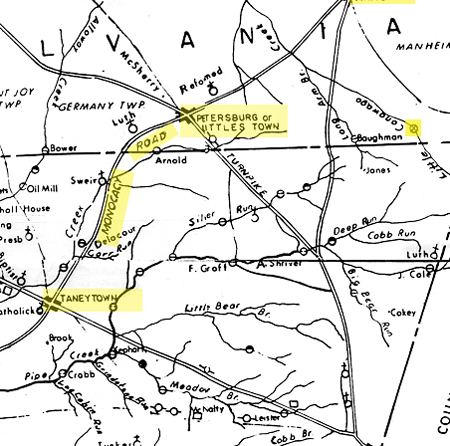
|
|
| Monocacy and Catoctin Area - ca. 1800 |
St John's Lutheran Church
Thomas Fisher was one of five founding trustees of St. John's Lutheran Church, southwest of Littlestown in 1763 (with deed of 1771 from Jacob and Anna Stehley). Prior to this the family worshiped at Conewago Union Church. Formed in 1738, Conewago Church in the Conewago Settlement was the first Brethren church in York County. The Conewago settlement dates from the 1730's and was one of first settlements in the region. It was located on the Monocacy Road and passed through what is now Hanover.
SOURCE: Monocacy and Catoctin C. E. Schildknecht, Editor
Chapter 14: Descendants of Thomas Fisher and Related Families
Fisher Family
Maria Eva König's parents were Abraham King/König (Abraham King/König ancestry.com page) (born Hoffen, Zweibrücken, Alsoce-Lorraine, France -28 FEB 1766) and Anna Maria Weymert (Weimer), married May 9, 1724 in Wurttenberg, Germany.
Thomas Friederich Fisher married (1) Eva King (eight children), born January 17, 1728, died before 1786. Eva was the daughter of Abraham and Anna Maria Koenig. She was born in Hoffen, Zweibrücken, Alsoce-Lorraine, France and died in York County, Pennsylvania, having immigrated to this country with her parents in 1751 aboard the ship "Janet", which arrived in Philadelphia on October 7, 1751. Thomas and Eve ran a tavern Littlestown, Pennsylvania.
Thomas married (2) Catherine Linebacher Graeff Miller, born 1750, died August 30, 1821. (one child). Thomas and Catherine ran a tavern in York, Pennsylvania.
Will of Thomas Fisher Sr.
March 19, 1790Children of Thomas Fisher and (1st wife) Eve King (Koenig) (marriages according to Monocacy and Catoctin):
Codicle to original Will dated 8/2/1791
Borough of York, York County, Pennsylvania
In the name of God Amen. I Thomas Fisher, Esq. of the town of York in the County of York in the State of Pennsylvania being in perfect health of sound ____ and memory thanks to God for his mercies calling to mind the mortality of my body and knowing that it is appointed for all men to die. Do the nineteenth Day of March in the year of our Lord one Thousand, Seven hundred and Ninety, make and establish this my Last Will and Testament in manner and for the following (that is to say) principally and above all I commit my Imortal soul unto the hands of God who gave it me and my body to the Earth to be buried after my Decease in a Christian decent manner at the discreation of my Executor. __ and as touching and concerning such worldly goods and E____ _s God in his Providence has ____ me with.
I give devise and Bequeath in way and manner following. Imprimis and
- first of all I order, will and Allow all my just Debts to be well and truly paid and discharged
- I give grant and Bequeath to my beloved wife Catherine Fisher all and singular my Household goods and effects which I shall be possessed of at my decease also the house and lot of ground wherein I now dwell and also the land she claimed and possessed at the time of our marriage to her use and Behoof forever to be disposed of and be bequeathed to whomever she pleases upon condition she _____ as ____charges the legacies herein after mentioned died
- Thirdly, I give and Bequeath to my son George Fisher, and to my Daughters Elizabeth Shryer and Eve Shryer, and to each and every of them the sum of five shillings they and every of them having received in full their Shares of me heretofore.
- Fourthly, I give and bequeath to my daughter Catherine Owler the sum of three Hundred Pounds and the my Daughter Mary Sell the sum of One Hundred and Seventy five Pounds to be paid them __ in Notes and Bonds which shall be in my Possession and __indue me at my Decease if so many there are, but if there should be not so much in Notes and Bonds then the remainder to be paid bt my Wife out of the property left her in the Sums of twenty five pounds Yearly.
- Fifthly, I give warrant and Bequeath to my son Thomas Fisher the building he now occupieth, and one hundred and Thirty acres of Land to be laid off contiguous, and Advantages to the Improvements aforesaid as the land will admit due re___ being had to timber Land and Meadow to be holden of him his heirs and Assigns forever, also I give and bequeath to the said Thomas all the other goods and Effects ____ I have already given him.
- Sixthly, I give grant and Bequeath to my sons James Fisher the Buildings he now occupieth and One Hundred and twenty Acres of Land to be laid off as aforsesaid withrespect had to the advantages aforesaid ____. to be holden of him and his heirs and Assigns forever also I give and Bequeath to the said James all the other Effects I have already given him married ___
- Seventhly, I give grant and Bequeath to my son Henry Fisher all and singular the rest and residue of my Lands in Germany Township, (or the value thereof), provided he does not marry a certain Catherine Little, but provided he will marry the said Catherine I order the sum _____said to be devided between sons Thomas and James upon their paying my Widow the sum of Thirty five shil___ per Acre in yearly payments to ______ her in paying off the ___cies aforesaid, but and if they will not accept of it at the price aforesaid then to be sold and conveyed by my Executors and the money to be appropriated for the use aforesaid and the Deed of Sale ____ by my Executors to be a sufficent barr against any Claim hereunto by my son Henry or any person under him either ____ or Equeity, and farther I order will and allow that if my son Henry should be intitled to the Land aforesaid and _____ that my sons Thomas and James shall have the first offer.
- Eigthly, I give and Bequeath to my grand daughter Mary ___nher the sum if Twenty five Pounds to be paid her as soon as of age by my Widow out of the Property aforesaid left her. Also order, Will and allow that if my sons aforesaid to whom ____ land aforesaid is devised cannot agree in dividing the farm ____ I three ___ different persons of the neighborhood shall be chosen with the concent of my Executors who shall devide the farm ____ devision shall be final and conclusive to all parties.
- Ninethly, I give and Bequeath to all any every of my grandchildren which is called for me the sum of Five Pounds each to be paid them as they arrive of age. Tenthly I give and Bequeath to my grand daughter Catherine Shryer the Sum of ten Pounds as soon as shall be convenent after my Decease.
- And Lastly I consitute Ordain and Appoint my loving Wife Catherine Fisher my son Thomas Fisher and Robert McIlhinny jointly to execute this Last Will and Testament according to the time ____ and meaning hereof ratifying can confirming this ____ other as my Last Will and Testament.
In witness whereof ____ hereunto set my hand and Seal the Day and Year first above ______ .
Thomas Fisher
sealSigned Sealed pronounced and declared by Thomas Fisher, Esq. and fo _______________
Codicil August 2, 1791
Whereas, I Thomas Fisher, Esq. late of Germany Township ___ now of the Borough of York in the County of York and State of Pennsylvania, made and Published my Last Will and Testament __ writing bearing date the Nineteenth Day of March in the year of our Lord One Thousand Seven Hundred and Ninety, which ___ Last Will and Testament and ever clause bequests and Devise ____rein contained I do hereby Ratify and and Confirm (save and except __ch Clauses and bequests therin mentioned as by me are are ho___ after revoked and made void) and being desirous to alter and __ making some Additions thereto, do therefore hereby make this __ codicil which I will and direct to be taken and held as a part of my Last Will and Testament. Whereas in my said ____ Will and Testament I did give and Bequeath to my beloved Wife Catherine ___ Fisher all and singular my Household goods and effect also the house and Lot of Ground wherein I now dwell, now I do hereby re___ and make void the said bequest of my Goods, Effects and House __ lot bequeathed as aforesaid to my wife and I will and __ler that she shall only have possession and free use and benefits __ the same until my son John Fisher attains to lawful age if she ___ long continue a Widow and if after said son John attains to lawful age and my said wife remains yet my Widow, I order then ___d it is my Will that she have and hold peaceful possession and Enjoyment of one third part of my said house and Lots and ____ of Ground and Buildings thereon erected, and one Third ___ all my Household Goods and Effects whatsoever for and during ___ Natural life if she so long Continue a Widow and if my said son dies without issue before he is of Age then my Wife shall keep and possess all my afs Estate Real and personal during her widowhood or till her intermarriage. Item, I give and Devise unto my son John Fisher and to his Heirs and Assigns forever, all that _____________________________ with the residue of my _____ Estate h__ not Bequeathed to Catherine my said Wife. To hot___ him my said son John when he arrives to lawful age, ___ner herein afore directed in care my Wife shall continue my Widow during her Natural life I also give and Bequeath my said Son John my large Family Bible, and my Silver Watch and I will that he be well educated and brought up ____ fear of God and to be obedient to his Mother as long ___ she liveth. Item, I hereby relinquish all my Right ___ to my Wife of the Land and Plantation possessed __ before our Intermarriage upon Condition that she pay ___ discharge, the Bequests adn Legacies mentioned in my __Will and if the case in case my Wife Catherine shall again marry __ then and in such case I will and direct that she shall ___ no more of my real Estate nor further Benefit than the Interest yearly of one third part of the valuation of __ Real Estate. In the Borough of York afs. and one there__ of my Personal Estate in full for her Dower Right and Clar___ of and in my Estate as well Real and Personal. Item in case son John shall die before he comes of age without lawful __ I then will direct that all the Real and Personal Estate to ___ above devised bequeathded shall be converted into money and equally divided to and amongst all my children born of the body of my former Wife and all the children born of the Body of my present Wife Catherine by her former two ____ lands in Portion and Share alike. In Witness whereof I have hereunto set my Hand and Seal the Second Day of August in the Year of Our Lord One Thousand Seven hundred and Ninety One.Thos Fisher SealSigned, Sealed, Published and declared by said Thomas Fisher as and for a codicil to his Last Will and Testament in presence of __ the word _ out being ___ inter_inedied George Gottwald, Jno Morris Jr.
A1 George Fisher, born 1752, died September 11, 1823 in Green Township, Harrison County, Ohio; married Catherine Elizabeth, born 1756 in Pennsylvania/Maryland, died October 19, 1838 in Green Township, Harrison County, Ohio.
1790 Thomas Fisher Sr. Will: "Thirdly, I give and Bequeath to my son George Fisher, and to my Daughters Elizabeth Shryer and Eve Shryer, and to each and every of them the sum of five shillings they and every of them having received in full their Shares of me heretofore. "
A2 Mary Margaret Elizabeth Fisher, born ca. 1754, died October 21, 1838 in Montgomery County, Ohio; married Jacob Shroyer, born 1746, died October 21, 1838; both are believed buried in David's Cemetery, Kettering, Montgomery County, Ohio.
A3 (Maria Eva) Eve Fisher, born ca. 1757; married (1) Joesph/Jacob Leitner; married (2) Jacob Schneider; married (3) May 26, 1807 in Trinity Reformed Church in York, Pennsylvania Jacob/Joseph Elgenfritz/Ilgenfritz .
B1 Mary Leightner.
B2 Anna Catherine Schreyer, born Dec. 30, 1786. Christened April 8, 1787, St. John's Lutheran Church Littlestown.
B3 Susanna Schneider (Schreyer), born March 15, 1800. Christened March 27, 1800 St. John's Lutheran Church Littlestown.
A4 Catherina Fisher, born 1759, died September 1, 1823; married ca. 1776 in Frederick County Maryland George Adam Ohler, born 1759, died 1839.
1790 Thomas Fisher Sr. Will: "Fourthly I give and bequeath to my daughter Catherine Owler the sum of three Hundred Pounds...."
B1 Anna Maria Ohler, born October 1777; christened November 9, 1777 at St. John's Church, Littlestown, Adams County, Pennsylvania.
B2 Thomas Ohler, born April 16, 1779; christened May 16, 1779 at St. John's Church, Littlestown, Adams County, Pennsylvania. Sponsors Thomas and Eva Fisher.
B3 Jacob Ohler, born December 31, 1800; christened August 2, 1801 at Trinity Evangelical Church, Tanneytown, Carroll County, Maryland.
A5 Maria Elizabeth (Marillas) Fisher, born 1761 in Pennsylvania, died 1820; married ca. 1780 Jacob Sell, born ca. 1735, died October 13, 1813, both are buried Evergreen Cemetery Gettysburg, Adams County, Pennsylvania.
1790 Thomas Fisher Sr. Will: "Fourthly I give and bequeath to my daughter... Mary Sell the sum of One Hundred and Seventy five Pounds to be paid them __ in Notes and Bonds which shall be in my Possession and __indue me at my Decease if so many there are, but if there should be not so much in Notes and Bonds then the remainder to be paid bt my Wife out of the property left her in the Sums of twenty five pounds Yearly."
A6 Thomas Fisher Jr., born April 30, 1763 died July 8, 1845 (Headstone); married Catherine Warner, December 16, 1769; died March 17, 1844 (Headstone). Both are buried in Elias Evangelical Lutheran Church Cemetery where they attended church. They farmed in southern Adams County, Cumberland Township near the Mason Dixon line and March Creek, mostly in Emmitsburg district of Frederick County.
1790 Thomas Fisher Sr. Will: "Fifthly I give warrant and Bequeath to my son Thomas Fisher the building he now occupieth, and one hundred and Thirty acres of Land to be laid off contiguous, and advantages to the Improvements aforesaid as the land will admit due re___ being had to timber Land and Meadow to be holden of him his heirs and Assigns forever, also I give and bequeath to the said Thomas all the other goods and Effects ____ I have already given him."
A7 Henry F. Fisher, born 1766 , died October 15, 1853, married Catherine Little (Klein) of Mt. Joy Township, born August 20, 1772.
1790 Thomas Fisher Sr. Will: "Seventhly, I give grant and Bequeath to my son Henry Fisher all and singular the rest and residue of my Lands in Germany Township, (or the value thereof), provided he does not marry a certain Catherine Little, but provided he will marry the said Catherine I order the sum _____said to be devided between sons Thomas and James upon their paying my Widow the sum of Thirty five shil___ per Acre in yearly payments to ______ her in paying off the ___cies aforesaid, but and if they will not accept of it at the price aforesaid then to be sold and conveyed by my Executors and the money to be appropriated for the use aforesaid and the Deed of Sale ____ by my Executors to be a sufficent barr against any Claim hereunto by my son Henry or any person under him either ____ or Equeity, and farther I order will and allow that if my son Henry should be intitled to the Land aforesaid and _____ that my sons Thomas and James shall have the first offer."
A8 Jacobus (James) Fisher, born 1767, died September 5, 1830; married 1778 Elizabeth Piper, born 1768, died September 5, 1845, both are buried Hanover Cemetery, Harrison County, Ohio.
1790 Thomas Fisher Sr. Will: "Sixthly I give grant and Bequeath to my sons James Fisher the Buildings he now occupieth and One Hundred and twenty Acres of Land to be laid off as aforsesaid with respect had to the advantages aforesaid ____. to be holden of him and his heirs and assigns forever also I give and Bequeath to the said James all the other Effects I have already given him."
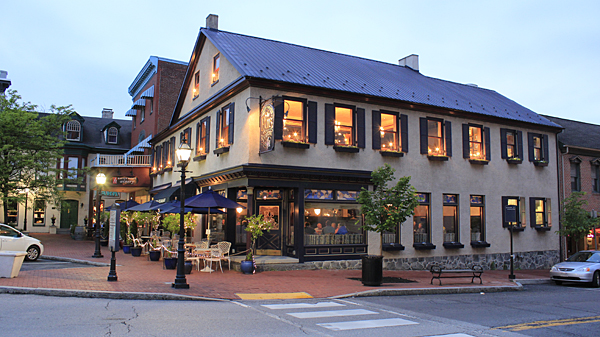
|
|
The Pub - Gettysburg, Pennsylvania Photograph taken May, 2016 |
Thomas Fisher child with 2nd wife Catherine Linebacher Graeff Miller; (Catherine's 1st husband was Gerhart Graeff; Catherine's 2nd husband was Casper Miller, died 1784). Thomas and Catherine ran a tavern in York, PA. (see photo - right)
Child of Thomas Fisher and Catherine Linebacher Graeff Miller :
A9 John Fisher, born August 1791. In Baltimore, died April 19, 1847; Maryland in 1812; John Fisher may have attended Medical School in Baltimore; married Ann ______.
1790 Thomas Fisher Sr. Will: "I also give and Bequeath my said Son John my large Family Bible, and my Silver Watch and I will that he be well educated and brought up ____ fear of God and to be obedient to his Mother as long ___ she liveth. Item in case son John shall die before he comes of age without lawful __ I then will direct that all the Real and Personal Estate to ___ above devised bequeathded shall be converted into money and equally divided to and amongst all my children born of the body of my former Wife and all the children born of the Body of my present Wife Catherine by her former two ____ lands in Portion and Share alike."
|
The George Fisher Family History is a compilation of information gathered by Eric & Liz Davis.
This HTML version was created by Eric and Elizabeth Fisher-Davis, beginning in 2001. Tree Outline of Fisher Generations |